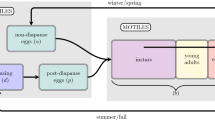Abstract
We consider a model for a creature inhabiting two patches between which migration may occur. The creature is assumed to have a life cycle with two stages, namely juvenile and adult, giving rise to a delay differential system. The creature could represent an insect crop pest whilst the patches could represent neighbouring farms. Given that it is common to control crop pests by adult impulsive culling, we impose an adult impulsive culling regime on each patch. We find conditions on the regimes such that the pest will be eradicated on both patches simultaneously. The regime on one patch is assumed to be independent of the regime on the other patch to reflect the possibility that the patches represent farms with different owners where each owner has autonomy in their pest control decisions. In the special case where the birth functions on both patches are of an Allee type, we calculate explicit finite upper bounds for the number of culls needed on each patch to guarantee eradication. Simulations corroborate our theoretical results.
Similar content being viewed by others
References
Donnelly CA, Woodroffe R, Cox DR, Bourne FJ, Cheeseman CL, Clifton-Hadley RS, Wei G, Gettinby G, Gilks P, Jenkins H, Johnston WT, Le Fevre AM, McInerney JP, Morrison WI (2006) Positive and negative effects of widespread badger culling on tuberculosis in cattle. Nature 439: 843–846
East IJ, Eisemann CH (1993) Vaccination against Lucilia cuprina: the causative agent of sheep blowfly strike. Immunol Cell Biol 71: 453–462
Epstein PR (2000) Is global warming harmful to health?. Sci Am 283: 50–57
Fradin MS (1998) Mosquitoes and mosquito repellents: a clinician’s guide. Ann Intern Med 128(11): 931–940
Gourley SA, Liu R, Wu J (2007) Eradicating vector-born diseases via age-structured culling. J Math Biol 54(3): 309–335
Gubler DJ (1998) Resurgent vector-borne diseases as a global health problem. Emerg Infect Dis 4(3): 442–450
Gurney W, Blythe S, Nisbet R (1980) Nicholson’s blowflies revisited. Nature 287: 17–21
Kuang Y (1993) Delay differential equations with applications in population dynamics. Academic Press, Boston
Lacey LA, Frutos R, Kaya HK, Vail P (2001) Insect pathogens as biological control agents: do they have a future?. Biol Control 21: 230–248
Liu Q, Dong S (2005) Periodic solutions for a delayed predator–prey system with dispersal and impulses. Electron J Differ Equ 31: 1–14
Luo Z, Dai B, Zhang Q (2010) Existence of positive periodic solutions for an impulsive semi-ratio-dependent predator–prey model with dispersion and time delays. Appl Math Comput 215: 3390–3398
Miller GT (2004) Sustaining the Earth, 6th edn, Chap 9, pp 211–216. Thompson Learning, Inc., Pacific Grove
Mischaikow K, Smith H, Thieme HR (1995) Asymptotically autonomous semiflows: chain recurrence and Lyapunov functions. Trans Am Math Soc 345(5): 1669–1685
O’Toole, C (eds) (1987) The encyclopedia of insects. Equinox (Oxford) Ltd., London
Shen J, Li J (2009) Existence and global attractivity of positive periodic solutions for impulsive predator–prey model with dispersion and time delays. Nonlinear Anal Real World Appl 10: 227–243
Simons RRL, Gourley SA (2006) Extinction criteria in stage-structured population models with impulsive culling. SIAM J Appl Math 66(6): 1853–1870
Smith HL (1995) Monotone dynamical systems: an introduction to the theory of competitive and cooperative systems. American Mathematical Society, Providence
So JW-H, Wu J, Zou X (2001) Structured population on two patches: modelling dispersal and delay. J Math Biol 43: 37–51
Terry AJ (2009) Control of pests and diseases. PhD thesis, University of Surrey
Terry AJ (2010) Impulsive adult culling of a tropical pest with a stage-structured life cycle. Nonlinear Anal Real World Appl 11(2): 645–664
Terry AJ, Gourley SA (2010) Perverse consequences of infrequently culling a pest. Bull Math Biol. doi:10.1007/s11538-009-9492-9
Trenkel VM (2001) Exploring red deer culling strategies using a population-specific calibrated management model. J Environ Manage 62(1): 37–53
van Aarde R, Whyte I, Pimm S (1999) Culling and the dynamics of the Kruger National Park African elephant population. Anim Conserv 2: 287–294
Author information
Authors and Affiliations
Corresponding author
Rights and permissions
About this article
Cite this article
Terry, A.J. Impulsive culling of a structured population on two patches. J. Math. Biol. 61, 843–875 (2010). https://doi.org/10.1007/s00285-009-0325-0
Received:
Revised:
Published:
Issue Date:
DOI: https://doi.org/10.1007/s00285-009-0325-0




